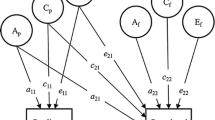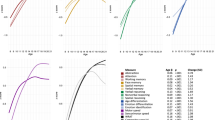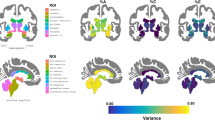Abstract
The prevalence of marriage varies across the lifespan, as does its importance to reproduction and the nurturance of children. We examined genetic and environmental influences on self-reported marriage at each decade from 20 through 70 years of age, using data collected for the Duke Dementia Study, a followed-up subset of the World War II Veteran Twin Registry. Genetic influences best fit a common factor model, supplemented by another, age-specific, genetic factor at age 30. Broad heritability increased from age 20 through 40, and then decreased to zero by ages 60 and 70. A longitudinal Cholesky model best described environmental influences on marriage across the lifespan. Shared environmental factors showed their greatest influence at age 20, no influence at 30 or 40 years, and then, reappeared with influence at 60 and 70. Variance due to error and unique environmental influences increased steadily to age 50 years and then declined slightly.





Similar content being viewed by others
References
Akaike H (1987) Factor analysis and AIC. Psychometrika 52:317–332
Amato PR, Previti D (2003) People’s reasons for divorcing: gender, social class, the life course, and adjustment. J Family Issues 24:602–626
Bergeman CS, Chipuer HM, Plomin R, Pedersen NL, McClearn GE, Nesselroade JR, Costa PT Jr, McCrae RR (1993) Genetic and environmental effects on openness to experience, agreeableness, and conscientiousness: an adoption/twin study. J Personality 61:159–179
Bouchard G, Lussier Y, Sabourin S (1999) Personality and marital adjustment: utility of the five-factor model of personality. J Marriage Family 61:651–660
Breitner JCS, Welsh KA, Gau BA, McDonald WM, Steffens DC, Saunders AM, Magruder KM, Helms MJ, Plassman BL, Folstein MF, Brandt J, Robinette CD, Page WF (1995) Alzheimer’s disease in the National Academy of Sciences – National Research Council Registry of aging twin veterans: III. Detection of cases, longitudinal results, and observations on twin concordance. Arch Neurol 52:763–771
Bureau of the Census (1999) Employment status of women, by marital status and presence and age of children: 1960 to 1998 (No. 659). Statistical abstract of the U.S.: 1999. Labor force status and participation. LexisNexis Academic & Library Solutions, a division of Reed Elsevier Inc
Camperio-Ciani A, Corna F, Capiluppi C (2004) Evidence for maternally inherited factors favouring male homosexuality and promoting female fecundity. Proc Roy Soc Biol Sci B 271(1554):2217–2221
Carey G (2005) Cholesky problems. Behav Genet 35:653–665
Cherlin AJ (2004) The deinstitutionalization of American marriage. J Marriage Family 66:848–861
D’Onofrio BM, Turkheimer E, Emery RE, Heath AC, Madden PA, Slutske WS, Martin NG (2005) A genetically informed study of marital instability and its association with offspring psychopathology. J Abnorm Psychol 114:570–586
Dunne MP, Martin NG, Statham DJ, Slutske WS, Dinwiddie SH, Bucholz KK, Madden PAF, Heath AC (1997) Genetic and environmental contributions to variance in age at first sexual intercourse. Psychol Sci 8:211–216
Edwards S, Self DW (2006) Monogamy: dopamine ties the knot. Nature Neurosci 9:7–8
Finkel D, Wille DE, Matheny AP Jr (1998) Preliminary results from a twin study of infant-caregiver attachment. Behav Genet 28:1–8
Fisher RA (1930) The genetical theory of natural selection. The Clarendon Press, Oxford
Gallese V (2003) The roots of empathy: the shared manifold hypothesis and the neural basis of intersubjectivity. Psychopathology 36:171–180
Gottesman II, Gould TD (2003) The endophenotype concept in psychiatry: etymology and strategic intentions. Am J Psychiat 160:636–645
Hughes KA, Burleson MH (2000) Evolutionary causes of genetic variation in fertility and other fitness components. In: Rodgers JL, Rowe DC, Miller WB (eds) Genetics influences on human fertility and sexuality. Kluwer Academic Publishers, Boston, pp 7–33
Jang KL, Livesley WJ, Vernon PA (1996) Heritability of the big five personality dimensions and their facets: a twin study. J Personal 64:577–591
Jockin V, McGue M, Lykken DT (1996) Personality and divorce: a genetic analysis. J Personal Social Psychol 71:288–299
Johnson W, McGue M, Krueger RF, Bouchard TJ Jr (2004) Marriage and personality: a genetic analysis. J Personal Social Psychol 86:285–294
Karney BR, Bradbury TN (1995) The longitudinal course of marital quality and stability: a review of theory, method, and research. Psychol Bull 118:3–34
Kendler KS, Neale MC, Kessler RC, Heath AC, Eaves LJ (1993) A test of the equal-environment assumption in twin studies of psychiatric illness. Behav Genet 23:21–27
King M, Green J, Osborn DPJ, Arkell J, Hetherton J, Pereira E (2005) Family size in white gay and heterosexual men. Arch Sexual Behav 34:117–122
Kirk KM, Blomberg SP, Duffy DL, Heath AC, Owens IPF, Martin NG (2001) Natural selection and quantitative genetics of life-history traits in Western women: a twin study. Evolution 55:423–435
Kohler HP, Rodgers JL, Christensen K (1999) Is fertility in our genes? Findings from a Danish twin study. Population Develop Review 25:253–288
Levenson RW, Carstensen LL, Gottman JM (1993) Long-term marriage: age, gender, and satisfaction. Psychol Aging 8:301–313
Loehlin JC, Martin NG (2001) Age changes in personality traits and their heritabilities during the adult years: evidence from Australian twin registry samples. Personal Individual Differences 30:1147–1160
Lykken DT, Tellegen A (1993) Is human mating adventitious or the result of lawful choice? A twin study of mate selection. J Personal Social Psychol 5:56–68
Maes HHM, Neale MC, Kendler KS, Hewitt JK, Silberg JL, Foley DL, Meyer JM, Rutter M, Simonoff E, Pickles A, Eaves LJ (1998) Assortative mating for major psychiatric diagnoses in two population-based samples. Psychol Med 28:1389–1401
McGue M, Lykken DT (1992) Genetic influence on risk of divorce. Psychol Sci 3:368–373
Miller WB, Pasta DJ, MacMurray J, Muhleman D, Comings DE (1999) Dopamine receptor genes are associated with age at first sexual intercourse. J Biosocial Sci 31:43–54
Neale MC, Cardon LR (1993) Methodology for genetic studies of twins and families. Kluwer Academic Publishers, Dordrecht, The Netherlands
Neale MC, Eaves LJ, Kendler KS (1994) The power of the classical twin study to resolve variation in threshold traits. Behav Genet 24:239–258
Pedersen NL, Reynolds CA (1998) Stability and change in adult personality: Genetic and environmental components. Eur J Personality 12:365–386
Pettay JE, Kruuk LEB, Jokela J, Lummaa V (2005) Heritability and genetic constraints of life-history trait evolution in preindustrial humans. Proc Natl Acad Sci 102:2838–2843
Rodgers JL, Kohler HP, Christensen K (2003) Genetic variance in human fertility: Biology, psychology, or both? In: Rodgers JL, Kohler HP (eds) The biodemography of human reproduction and fertility. Kluwer Academic, Boston
Rodgers JL, Kohler HP, Kyvik KO, Christensen K (2001) Behavior genetic modeling of human fertility: findings from a contemporary Danish twin study. Demography 38:29–42
Rodgers JL, Rowe DC, Buster M (1999a) Nature, nurture and first sexual intercourse in the USA: fitting behavioural genetic models to NLSY kinship data. J Biosocial Sci 31:29–41
Rodgers JL, Nakonezny PA, Shull RD (1997) The effect of no-fault divorce legislation on divorce rates: a response to reconsideration. J Marriage Family 59:1026–1030
Rodgers JL, Nakonezny PA, Shull RD (1999b) Did no-fault divorce legislation matter? Definitely yes and sometimes no. J Marriage Family 61:803–809
Rushton JP, Bons TA (2005) Mate choice and friendship in twins: evidence for genetic similarity. Psychol Sci 16:555–559
Sakai JT, Stallings MC, Mikulich-Gilbertson SK, Corley RP, Young SE, Hopfer CJ, Crowley TJ (2004) Mate similarity for substance dependence and antisocial personality disorder symptoms among parents of patients and controls. Drug Alcohol Dependence 75:165–175
Spotts EL, Lichtenstein P, Pedersen N, Neiderhiser JM, Hansson K, Cederblad M, Reiss D (2005) Personality and marital satisfaction: a behavioural genetic analysis. Eur J Personality 19:205–227
Trent K, South SJ (2003) Spousal alternatives and marital relations. J Family Issues 24:787–810
Trumbetta SL (2004) Middle age, marriage, and health habits of America’s Greatest Generation: Twins as tools for causal analysis. In: DiLalla LF (ed) Behavior genetic principles—Development, personality, and psychopathology. American Psychological Association, Washington, DC, pp 59–70
Trumbetta SL (2001) Health habits, marriage, and divorce during the Greatest Generation’s middle age. Paper presented at Behavior Genetic Principles—Development, Personality, and Psychopathology: A Festschrift in honor of Professor Irving I. Gottesman. University of Minnesota, Minneapolis, Minnesota
Trumbetta SL (1997) A twin study of marital status. Doctoral dissertation, University of Virginia, 1996. Dissertation Abstracts International 57:5347
Trumbetta SL, Gottesman II (2000) Endophenotypes for marital status in the NAS-NRC twin registry. In: Rodgers JL, Rowe DC, Miller WB (eds) Genetics influences on human fertility and sexuality. Kluwer Academic Publishers, Boston, pp 253–269
Trumbetta SL, Gottesman II (1997) Pair bonding deconstructed by twin studies of marital status: What is normative? In: Segal NL, Weisfeld GE, Weisfeld CC (eds) Uniting psychology and biology: Integrative perspectives on human development: essays in honor of Daniel G. Freedman. American Psychological Association, Washington DC, pp 485–491
Trumbetta SL, Gottesman II, Turkheimer EN (1995) There are no genes for divorce: there is genetic variation in heterosexual pair bonding [Abstract]. Behav Genet 25:291
Trumbetta SL, Phillips K (1998) Assortative mating for MMPI-2 personality traits in a sample of parents of twins [Abstract]. Behav Genet 28(6):483
Turkheimer E, Haley A, Waldron M, D’Onofrio B, Gottesman II (2003) Socioeconomic status modifies heritability of IQ in young children. Psychol Sci 14:623–628
Turkheimer E, Lovett G, Robinette C, Gottesman I (1992) The heritability of divorce: New data and theoretical implications [Abstract]. Behav Genet 22:757
Udry JR (1996) Biosocial models of low-fertility societies. Population and Development Review 22(Supplement):325–336
van Beijstervelt CEM, Bartels M, Hudziak JJ, Boomsma DI (2003) Causes of stability of aggression from early childhood to adolescence: a longitudinal genetic analysis in Dutch twins. Behav Genet 33:591–605
Vanyukov MM, Moss HB, Tarter RE (1994) Assortment for the liability to substance abuse and personality traits. Annals NY Acad Sci 708:102–107
Viken RJ, Rose RJ, Kaprio J, Koskenvuo M (1994) A developmental genetic analysis of adult personality: extraversion and neuroticism from 18 to 59 years of age. J Person Soc Psychol 66:722–730
Xian H, Scherrer JF, Eisen SA, True WR, Heath AC, Goldberg J, Lyons MJ, Tsuang MT (2000) Self-reported zygosity and the equal-environments assumption for psychiatric disorders in the Vietnam Era Twin Registry. Behav Genet 30:303–310
Young LJ, Wang Z, Insel TR (1998) Neuroendocrine bases of monogamy. Trends Neurosci 21:71–75
Zuckerman M (2002) Genetics of sensation seeking. In: Benjamin J, Ebstein R, Belmaker RH (eds) Molecular genetics and the human personality. American Psychiatric Publishing, Inc., Washington, DC, US
Acknowledgments
The authors appreciate the contributions of the administrators of the NAS-NRC World War II Veteran Twin Registry, particularly Dr. William Page, Ms. Harriett Crawford, and the late Dr. Dennis Robinette of the Medical Follow-up Agency, and those of the investigators and staff of the Duke Dementia Study, especially Dr. John Breitner, Dr. Brenda Plassman, and Ms. Debbie Drosdick, to the collection and archiving of these data. We are especially grateful to the World War II Veteran twins whose generous participation over many decades has created an invaluable repository of data for medical and scientific research. Our paper was enhanced by the observations and insights of Joe Rodgers and another, anonymous reviewer, and we are very grateful for their suggestions. Finally, we appreciate the support Vassar College provided through its Undergraduate Research Summer Institute (URSI) and a faculty study leave.
Author information
Authors and Affiliations
Corresponding author
Additional information
Edited by Richard Rose
Rights and permissions
About this article
Cite this article
Trumbetta, S.L., Markowitz, E.M. & Gottesman, I.I. Marriage and Genetic Variation across the Lifespan: Not a Steady Relationship?. Behav Genet 37, 362–375 (2007). https://doi.org/10.1007/s10519-006-9132-1
Received:
Accepted:
Published:
Issue Date:
DOI: https://doi.org/10.1007/s10519-006-9132-1




